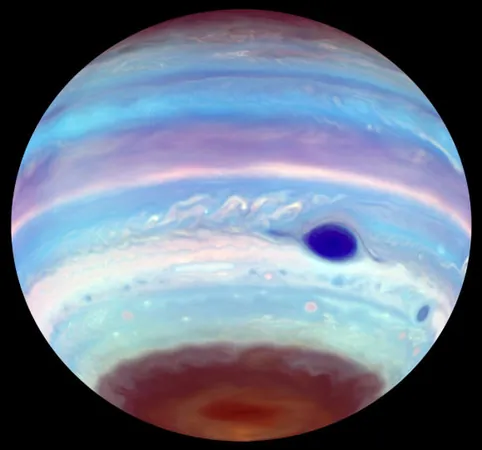
Mysterious Dark Polar Ovals on Jupiter Captured by Astronomers in Groundbreaking Study
2024-11-28
Author: Wei Ling
Introduction
Astronomers have made a stunning discovery regarding Jupiter's poles with the observation of unusual, transient ultraviolet (UV) dark ovals. These Earth-sized ovals, which appear and vanish seemingly at random, were seen at both the north and south poles of the gas giant, shedding light on intriguing processes within its towering atmosphere.
Observations from Hubble
According to researchers from the University of California, Berkeley, these dark UV ovals typically lie just beneath the planet's bright auroral zones—regions that resemble Earth's northern and southern lights. When these spots are visible, they absorb more ultraviolet light than their surroundings, giving them a darker appearance in images captured by the NASA/ESA Hubble Space Telescope.
Statistical Analysis
A comprehensive analysis of Hubble's images taken over seven years (2015-2022) revealed that the dark UV ovals were detected 75% of the time at the south pole but appeared in only one out of eight observations at the north pole. This pattern suggests significant atmospheric dynamics that may differ drastically between Jupiter's polar regions.
Historical Context
First identified in the 1990s, these dark ovals were previously overlooked until a new investigation, led by undergraduate Troy Tsubota, focused on Hubble’s archival images. The study showed that the southern dark UV ovals—dubbed Southern UV-Dark Ovals (SUDO)—were common, with researchers cataloging eight such features between 1994 and 2022. In contrast, only two Northern UV-Dark Ovals (NUDO) were discovered in the north.
Potential Mechanisms
Further analysis indicated that these mysterious ovals might be influenced by a vortex generated as magnetic field lines interact with the atmosphere. This process potentially begins in the ionosphere—a region high above the planet—where powerful spinning motions have been previously detected. The influence of Io, Jupiter's volcanic moon, could also play a role, as the hot plasma it emits may amplify these vortex structures.
Formation and Characteristics
The researchers hypothesized that these dark spots take about a month to develop and can dissipate within a couple of weeks. Notably, the haze within the ovals is estimated to be 50 times denser than ambient concentrations, suggesting that these areas form primarily through dynamic vortex activities rather than from chemical reactions spurred by high-energy particles common in planetary atmospheres.
Significance of the Study
The breakthrough insights into Jupiter’s atmospheric dynamics significantly contribute to the Outer Planet Atmospheres Legacy (OPAL) project, aiming to better understand the atmospheric processes of giant planets compared to those on Earth. Dr. Michael Wong, another prominent researcher in the study, emphasized that exploring connections across various atmospheric layers is crucial for our knowledge of planetary systems, including those far beyond our solar system.
Conclusion
This remarkable research showcases how Jupiter’s complex atmospheric behavior may hold clues not only to the planet itself but also offers insights into the cosmic dance of planetary atmospheres within the solar system. The findings were published in the journal *Nature Astronomy*, and they mark an important milestone in planetary science. Prepare to be amazed by the wonders of our universe as ongoing studies seek to unveil the secrets of Jupiter and its breathtaking, chaotic beauty!


 Brasil (PT)
Brasil (PT)
 Canada (EN)
Canada (EN)
 Chile (ES)
Chile (ES)
 España (ES)
España (ES)
 France (FR)
France (FR)
 Hong Kong (EN)
Hong Kong (EN)
 Italia (IT)
Italia (IT)
 日本 (JA)
日本 (JA)
 Magyarország (HU)
Magyarország (HU)
 Norge (NO)
Norge (NO)
 Polska (PL)
Polska (PL)
 Schweiz (DE)
Schweiz (DE)
 Singapore (EN)
Singapore (EN)
 Sverige (SV)
Sverige (SV)
 Suomi (FI)
Suomi (FI)
 Türkiye (TR)
Türkiye (TR)